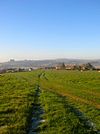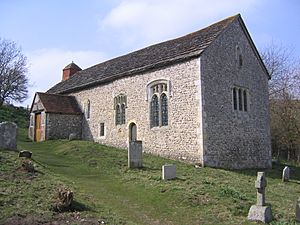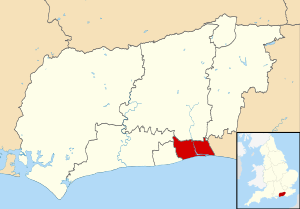List of places of worship in Adur facts for kids
Adur is a district in West Sussex, England. It has 26 churches and other places where people worship, plus 5 old churches that are not used for religious services anymore. Most of these churches are in the towns and villages along the coast, which are part of a big built-up area including Brighton and Worthing. The northern part of Adur is more rural and has one very old church still in use. People of many Christian faiths worship here, but followers of other religions usually need to travel outside the area to find their places of worship.
Seven of Adur's current places of worship, and two former churches, are "listed buildings." This means they are officially recognized as having special architectural or historical importance. The government department in charge of this is the Department for Culture, Media and Sport. English Heritage helps manage the process and gives advice. There are three levels of listed status:
- Grade I: For buildings of "exceptional interest"—these are very important!
- Grade II*: For "particularly important buildings" that are more than just special.
- Grade II: For buildings that are simply "special."
By the 11th century, the area that is now Adur district already had several small villages, each with its own church. Even though some have been repaired and changed over the years, many of their original parts and features are still there. These include a special room where a hermit (a religious person who lived alone) was walled up for life, rare old wall paintings, a unique type of gate found only in Sussex called a Tapsel gate, and a tower roof shape called a "Rhenish helm" which is the only one of its kind in England.
Contents
Where is Adur?
Adur covers about 4,180 hectares (that's about 10,330 acres). It's a coastal area between the beautiful South Downs hills and the English Channel. The city of Brighton and Hove is to its east, and Worthing is to its west. The River Adur, which gives the district its name, flows from north to south and splits the area in two.
In the Saxon and Norman times (many hundreds of years ago), villages grew up on both sides of the river. These included Southwick, Kingston Buci, and Shoreham on the east side, and Lancing and Sompting on the west. Each of these villages had its own ancient church. As these places grew, they joined together to form one big urban area, taking in smaller places like Upper Cokeham, Lower Cokeham, and Fishersgate. Houses spread up the lower parts of the Downs hills, but not much was built north of the Old Shoreham Road, which was a main road built in the 1700s. Today, the A27 road marks the northern edge of the main towns.
Churches were already built in Southwick, Kingston Buci, Old Shoreham, Sompting, the village of Coombes (up on the Downs), and the now-empty village of Old Erringham by the year 1086, when the Domesday Book was written. The church in New Shoreham was built by the end of the 11th century, and Lancing had one by the 12th century.
Who Worships Here?
In 2021, about 64,544 people lived in Adur district. Here's a quick look at their religious beliefs:
- About 43% said they were Christian.
- About 1.3% were Muslim.
- About 0.42% were Buddhist.
- About 0.39% were Jewish.
- About 0.32% were Hindu.
- About 0.05% were Sikh.
- About 0.61% followed another religion.
- About 47.86% said they had no religion.
- About 5.92% did not say what their religion was.
The number of people in Adur who said they had no religion was higher than the average for England. The number of Christians was a little lower than the national average. Other religions like Islam, Judaism, Hinduism, Buddhism, and Sikhism also had fewer followers in Adur compared to the rest of England.
How Churches are Organized
Adur's 11 Church of England churches are part of the Diocese of Chichester. This is like a big area managed by a bishop, with its main church (cathedral) in Chichester. These churches are further grouped into smaller areas called Deaneries. For example, the churches in Coombes, Lancing, and Sompting are in the Worthing Deanery. The churches in Shoreham-by-Sea, Kingston Buci, and Southwick are in the Hove Deanery.
The Roman Catholic Diocese of Arundel and Brighton looks after Adur's Roman Catholic churches. Their main church is Arundel Cathedral. St Peter's Church in Shoreham-by-Sea is part of a larger group of churches called the parish of Our Lady Queen of Peace, Adur Valley. St Theresa of Lisieux Church in Southwick is part of a combined parish with churches in Brighton and Hove. The Church of the Holy Family in Lancing is part of a parish in nearby Worthing.
Southwick Christian Community Church belongs to the Congregational Federation, which is a group of independent churches. This group formed in 1972 when some churches wanted to stay independent instead of joining the new United Reformed Church. Both Southwick Christian Community Church and Shoreham Baptist Church are also part of Baptists Together, a larger group of Baptist churches in Great Britain. Shoreham Baptist Church is also a member of the Evangelical Alliance. Lancing Tabernacle is part of the Fellowship of Independent Evangelical Churches.
The three Methodist churches in Adur (in Lancing, Shoreham-by-Sea, and Southwick) are part of the West Sussex (Coast and Downs) Methodist Circuit, which includes 15 churches.
Churches You Can Visit Now
| Name | Image | Location | Religion/ Group |
Grade | Cool Facts | More Info |
|---|---|---|---|---|---|---|
| Coombes Church |  |
Coombes | Church of England | I | The main part of the church, the entrance door, and the arch leading to the altar area are from the original 11th-century building. The church was rebuilt in the 1700s after part of it fell down. Amazing wall paintings from the 1100s and later were found in 1949. The churchyard has a rare "Tapsel gate," a special design only found in Sussex. | |
| Lighthouse Community Church |  |
Fishersgate | Assemblies of God | – | This building was first used as a mission hall in 1909. It changed its name several times and is now connected with the Assemblies of God Pentecostal group. | |
| St Giles' Church |  |
Kingston Buci | Church of England | – | Built in 1906, this church was originally a chapel for the local workhouse (now Southlands Hospital). In 1934, it became part of St Julian's Church parish and opened for public worship. | |
| St Julian's Church |  |
Kingston Buci | Church of England | I | This church was here during the Domesday survey (1086), and some parts from the 11th century are still standing. There are also remains of a small cell where a hermit lived in medieval times, built into the wall near the altar. | |
| St James the Less Church |  |
Lancing | Church of England | I | This church, mostly built in the 13th century with flint, has a Norman-era doorway in its south porch. The baptismal font (a large bowl for baptisms) is from the 12th century. The tower got a new pyramid-shaped roof in the 17th century. | |
| St Michael and All Angels Church |  |
Lancing | Church of England | – | A smaller church was built for South Lancing in 1879, followed by a temporary iron church in 1893. In 1924, a permanent building was designed in the 14th-century Gothic style. An extension added in the 1950s uses brick, which is different from the original flint and stone. | |
| Lancing Tabernacle |  |
Lancing | Evangelical | – | The first church with this name was a Railway Mission hall. The wooden building from 1927 was moved to Fittleworth when a new red-brick Tabernacle opened nearby in 1937. | |
| Lancing Methodist Church |  |
Lancing | Methodist | – | A Methodist church existed in South Lancing by 1833. As it grew, a larger church was built on the same spot in 1904 in the Early English style. It has a tower and a spire, and a new porch was added in 1979. | |
| Brethren Meeting Room |  |
Lancing | Exclusive Brethren | – | A Brethren community started in Lancing in the 1930s. Their first place of worship was in First Avenue, but they later moved to this new building in Wembley Gardens. | |
| Church of the Holy Family |  |
Lancing | Roman Catholic | – | From 1954, a former farmhouse was used for Catholic services. It was later extended. A new church was built next to it, opening in 1971. This new church, "attractive in its simplicity," is made of concrete and dark red brick, with a tower on the corner. | |
| St Peter the Apostle's Church |  |
Lower Cokeham, Sompting | Church of England | – | This modern brick building is part of the St Mary the Blessed Virgin parish. It was made a church in 1966 and is used as both a church hall and a place of worship. | |
| Kingdom Hall |  |
Lower Cokeham, Sompting | Jehovah's Witnesses | – | This new Kingdom Hall opened in 2014, replacing an older building used since 1960. It serves the Lancing group of Jehovah's Witnesses. | |
| Church of the Good Shepherd |  |
Shoreham Beach | Church of England | – | Architect Charles Latham designed this church for the Shoreham Beach area after a storm in 1913 destroyed many wooden houses. His Early English-style building opened in 1913 and was made bigger in 1971. | |
| Providence Strict Baptist Chapel |  |
Shoreham-by-Sea | Baptist | – | This small building, with a simple classical style, opened in 1867 to replace an older meeting room nearby. It is part of the Gospel Standard movement. | |
| St Mary de Haura Church |  |
Shoreham-by-Sea | Church of England | I | This church was built in the 11th century to serve the Port of Shoreham and was very large. The eastern part of the original building is still standing and forms the current church. It was rebuilt in the 1700s after being in ruins. | |
| St Nicolas' Church |  |
Shoreham-by-Sea | Church of England | I | Old Shoreham's church is even older than the Norman Conquest (1066) and was dedicated by the 11th century. Most of the building you see today was built around 1140, though it was repaired in 1839–1840. The area where the main parts of the church cross has some cool carved faces. | |
| Shoreham Baptist Church |  |
Shoreham-by-Sea | Baptist | – | Built in 1880, this chapel replaced a smaller one from 1870. It was designed in an Italianate style with plastered walls, which have since been painted over. | |
| Shoreham Free Church |  |
Shoreham-by-Sea | Countess of Huntingdon's Connexion | – | The Countess of Huntingdon's Connexion started its first church in Shoreham in 1800. The current building has a red-brick front from 1958, but the original structure from 1906 (made of brick and terracotta) is still behind it. It stands on the corner of Buckingham and Gordon Roads. | |
| Shoreham Methodist Church |  |
Shoreham-by-Sea | Methodist | – | This church was built in 1900 as a Wesleyan Methodist chapel, replacing an earlier one from 1829. It was designed in a Perpendicular Gothic style using red brick and flint. A glass porch was added in 1995. | |
| St Peter's Church |  |
Shoreham-by-Sea | Roman Catholic | – | After the town's first Catholic church closed in 1982, this new building opened nearby on the site of a Catholic school. Construction began in 1983, and the new church opened in April 1984. | |
| Church of St Mary the Blessed Virgin |  |
Sompting | Church of England | I | This church is famous for its German-style "Rhenish helm" spire, which is unique in England, and its Anglo-Saxon tower. Many parts of the church from the 11th and 12th centuries are still there, including additions made by the Knights Templar and Knights Hospitaller, who used to own the church. | |
| St Michael and All Angels Church |  |
Southwick | Church of England | II* | Southwick's flint-built church was managed from Kingston Buci in its early years. Most of the building is from the 12th and 13th centuries, but you can still see parts of Norman walls, and the main hall (nave) is from the 14th century. The tower was damaged by bombing in World War II but was repaired. | |
| Southwick Christian Community Church |  |
Southwick | Congregational Federation | – | Modern additions hide the fact that this building started as a "traditional chapel" in 1903. It was originally a plastered building with small round-arched windows. A large extension was added to the east in 2003, costing over £1 million. | |
| Southwick Methodist Church |  |
Southwick | Methodist | – | Southwick's first Methodist church was used from 1876 to 1955. This current building opened in 1955. A larger building, connected by a modern porch, opened on June 4, 1966. | |
| St Theresa of Lisieux Church |  |
Southwick | Roman Catholic | – | Before 1950, Catholics in Southwick had to travel to other places to worship. Mass began to be held in a private house in 1950. A Romanesque-style church was built next to the Old Shoreham Road in 1955. It was first a smaller church connected to the one in Portslade, but it became its own separate church in 1956. | |
| Sompting United Reformed Church |  |
Upper Cokeham, Sompting | United Reformed Church | – | The Congregational community started a church in Sompting in 1936 in a brick building. Since the Congregational Church became part of the United Reformed Church in the 1970s, this church has served that group. |
Old Churches No Longer in Use
| Name | Image | Location | Religion/ Group |
Grade | Cool Facts | More Info |
|---|---|---|---|---|---|---|
| St Peter and St Mary's Church |  |
Fishersgate | Church of England | – | A mission hall opened here in 1881. It was replaced in 1938 by a Romanesque-style church made of dark brick and tiles, with a short tower and spire. It stopped being used as a church in November 2008 and is now the Stepping Stones Children and Family Centre. | |
| Erringham Chapel |  |
Old Erringham | Pre-Reformation | II | This chapel was built in the 11th century for the village of Old Erringham, which is now empty. It stopped being used before the Reformation (a big change in the church in the 1500s). The remains of its altar area have been turned into a barn. It's on private land, so you can only see it from a distance. | |
| St Peter's Church |  |
Shoreham-by-Sea | Roman Catholic | II | Shoreham's first permanent Catholic church was finished in 1875. It was designed in a 13th-century Gothic style using flint and stone, and had a small bell tower. A rich lady, Augusta, Duchess of Norfolk, paid for it. It was replaced by a new church in 1982 and then became a nursing home, and now it's flats. | |
| West Street Primitive Methodist Chapel |  |
Shoreham-by-Sea | Methodist | – | This classical-style chapel opened in 1862 for the Primitive Methodist community. When a new chapel opened in 1879, this building became a Salvation Army hall. Since the 1930s, it has been the Shoreham Snooker Club. You can still see the round-arched windows on the side. | |
| Southwick Undenominational Mission Hall | Southwick | Non-denominational | – | This mission hall on Cross Road in Southwick was used for religious worship in 1932. In 1978, permission was given to change it into a house. |
See also
- Grade I listed buildings in West Sussex
- Listed buildings in Adur
- List of demolished places of worship in West Sussex



